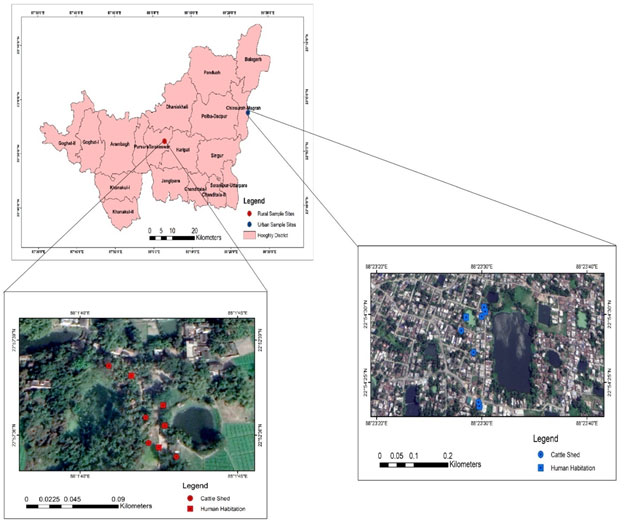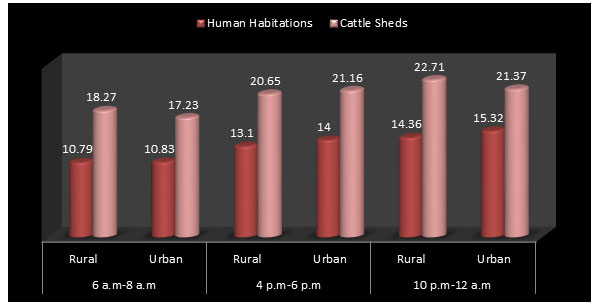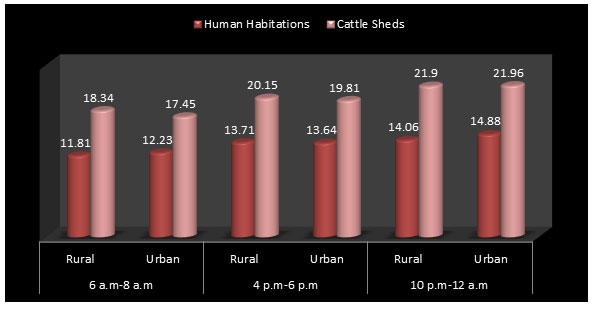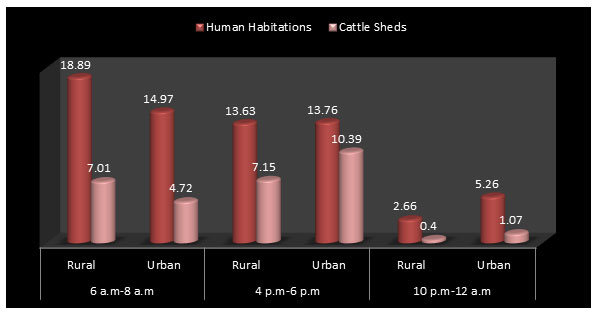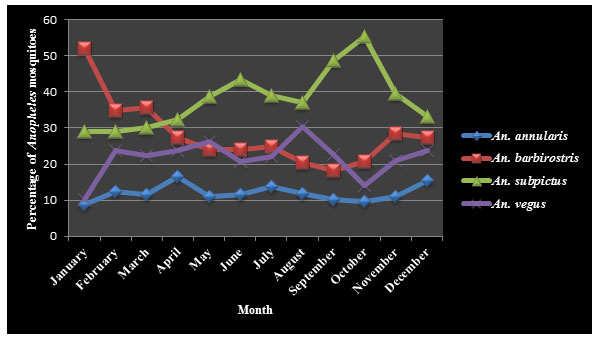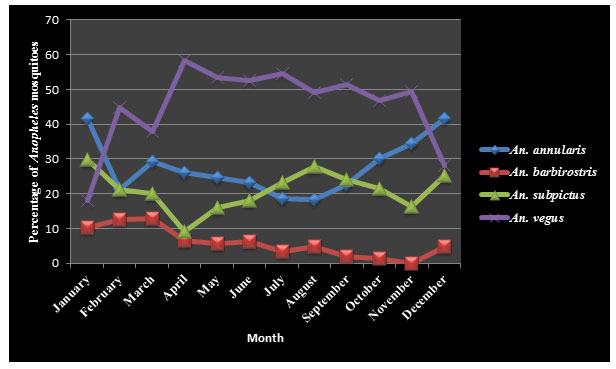Parasitology and Microbiology Research Laboratory, Department of Zoology, The University of Burdwan. Golapbag Burdwan, Pin: 713104 India
Corresponding author email: soumen.microbiology@gmail.com
Article Publishing History
Received: 12/01/2020
Accepted After Revision: 28/02/2020
Several mosquito genera such as Anopheles, Culex and Aedes serve as vectors of numerous deadly diseases throughout the world. Prevalence of these diseases strongly coincides with the prevalence of their respective vectors. During the present study adult mosquitoes of three genera (Anopheles, Culex and Aedes) were collected from selected four cattle sheds and four human habitations in both rural and urban areas of Hooghly district, West Bengal through hand collection method employing four man hours (two for human habitations and two for cattle sheds) in the first week of every month throughout the year (Jan’18 – Dec’18). Environmental temperature, humidity were recorded and GPS location of the collection points were plotted on the study area map. Altogether 4754 Anopheles (56.36%), 3312 Culex (39.26%) and 369 Aedes (4.37%) mosquitoes were collected from rural areas and 3766 Anopheles (50.16%), 3302 Culex (44.38%) and 372 Aedes (5%) mosquitoes were collected from urban areas. Anopheles and Culex mosquitoes showed higher prevalence in cattle sheds than human habitations in both rural and urban areas, whereas reverse situation is shown by Aedes mosquitoes. Monthly prevalence of different species of Anopheles also showed a significant difference between rural and urban areas (p<0.01). This study indicated that Anopheles and Culex mosquitoes are more prevalent in cattle sheds besides human habitations. Present study will illuminate about the resting-habitats in relation to mosquito ecology so that proper management strategies may be taken with a view to prevent the mosquito borne diseases in the endemic areas of Hooghly District.
Mosquitoes; Prevalence; Human habitations; Cattle sheds; Disease
Seal M, Chatterjee S. Prevalence of Three Mosquito Vectors: Anopheles, Culex and Aedes in Some Areas of Hooghly West Bengal, India. Biosc.Biotech.Res.Comm. 2020;13(1).
Seal M, Chatterjee S. Prevalence of Three Mosquito Vectors: Anopheles, Culex and Aedes in Some Areas of Hooghly West Bengal, India. Biosc.Biotech.Res.Comm. 2020;13(1). Available from: https://bit.ly/3cC8JmH
Copyright © Seal and Chatterjee, This is an open access article distributed under the terms of the Creative Commons Attribution License (CC-BY) https://creativecommons.org/licenses/by/4.0/, which permits unrestricted use distribution and reproduction in any medium, provide the original author and source are credited.
INTRODUCTION
Mosquitoes belonging to several genera mainly Anopheles, Culex and Aedes serves as nuisance vectors of numerous deadly diseases like malaria, filaria, dengue etc. occurring throughout the world (Mondal et al, 2015). Several species of Anopheles mosquitoes severs as a vector of different types of malaria in tropical and subtropical countries . Anopheles gambiae and Anopheles funestus serves as the main malarial vector in African countries (Lindh et al, 2005).Whereas Anopheles culicifacies serves as the main malarial vector in Asian countries (Chatterjee and Chandra, 2000;Chavshin et al, 2014 Lindh et al, 2015 Seal et al 2018).
It was reported that in some rural areas of Hooghly district, West Bengal Anopheles subpictus Grassi serves as the main malarial vector (Chatterjee and Chandra, 2000). Some Culex species mostly Culex vishnui group and Culex quinquifasciatus serves as a vector of Japanese encephalitis, lymphatic filariasis in many regions of India (Kanojia et al 2003) and West Bengal also (Chandra et al, 2007; Azmi et al, 2015), whereas some species of Aedes mosquitoes like Aedes aegypti and Aedes albopictus globally transmits dengue fever (Gubler 2002). In all the cases adult female mosquitoes are responsible for the transmission of disease causing pathogens. So, the prevalence of these diseases is strongly coincides with the prevalence of two factors: one is the abundance of the respective vectors and second one is the introduction of the disease causing pathogens in the suitable host, which are mostly dependent on environmental conditions like temperature, humidity, rainfall, availability of suitable breeding grounds, (Khan et al, 2017).
For the purpose of management of diseases, adult control strategies are mostly used today, which uses several insecticides like DDT, malathion, pyrethroid to control the adult mosquitoes. In this regard it is very important to have a better knowledge about the ecology of mosquitoes especially their resting site preference and biting behavior throughout the different times of a year (Alten et al, 2000). Reports on prevalence of different mosquitoes in rural and urban areas of Hooghly district, West Bengal are very scanty. So, the present study has been aimed to determine the month wise prevalence of three genera of adult mosquito vectors like Anopheles, Culex and Aedes in some rural and urban areas of Hooghly district, West Bengal, India along with the species composition of anopheline mosquitoes and to find out their correlations with some environmental factors like temperature and humidity throughout the year. This study would have a great impact on better understanding of mosquito ecology and their proper management strategies in the study areas.
MATERIALS AND METHODS:
The entire study was performed monthly for one year starting from January’2018 to December’2018.The entire study was carried out in some rural and urban areas of Hooghly district, West Bengal, India. For the collection of adult mosquitoes four human habitations and four cattle sheds were fixed in both rural and urban areas. The location of the study areas were recorded with a hand held GPS (Germin Etrex201 model) and thereafter these way points were superimposed on study area map and satellite image (Fig.1).
The adult mosquitoes were collected by hand collection method from four fixed human habitations and four cattle sheds in each of rural and urban areas of Hooghly. Four man hours (two for human habitations and two for cattle sheds) were employed for the collection of the adult mosquitoes and the collection was done in three different time periods (morning: 6 am – 8 am; afternoon: 4 pm – 6 pm and night: 10 pm-12 am) of the same day in the first week of every month. The duration of collection time was fifteen minutes in each place. Both the indoor biting and resting mosquitoes were collected in test tubes with a small piece of net plugged at mouth of the tubes and on the next day they were brought to the Parasitology and Microbiology Research Laboratory for their identification. The environmental temperature and humidity of the collection points were recorded by Fischer Scientific machine.
In laboratory the mosquitoes were anesthetized by applying chloroform to cotton and plugging on the opening of the tubes containing adult mosquitoes. Then the mosquitoes were shorted morphologically according to the genus under a dissecting binocular. The total number of Anopheles, Culex and Aedes mosquitoes were noted down. Then the collected Anopheles mosquitoes were sorted out according to the species following Nagpal and Sharma (1995) and their numbers were noted down. Statistical analysis was performed following Zar, (1999) using SPSS software version 16.0.
RESULTS AND DISCUSSION
The locations of cattle sheds and human habitations in rural and urban study areas are given in Figure 1. The distance between rural and urban areas was 37.72km (Figure 2). Total 4754 Anopheles (56.36%), 3312 Culex (39.26%) and 369 Aedes (4.37%) mosquitoes were collected from rural areas and 3766 Anopheles (50.16%), 3302 Culex (44.38%) and 372 Aedes (5%) mosquitoes were collected from urban areas throughout the year. Month wise prevalence of three genera of adult mosquitoes (Anopheles, Culex and Aedes) in human habitations and cattle sheds in rural areas and urban areas are given in Table 1-3 and in Table 4-6 respectively. During the whole study period Anopheles and Culex mosquitoes showed higher prevalence in cattle sheds (81.42±7.14 and 77.67±7.02 respectively) than human habitations (50.64±4.58 and 50.92±4.2 respectively) in rural areas which was statistically significant (p<0.01).
Table 1. Month wise prevalence of three genus of mosquitoes (Anopheles, Culex and Aedes) in human habitations and cattle sheds in rural areas of Hooghly District (Day time: 6a.m-8a.m from Jan’2018-Dec’2018)
| Month | Temperature
(0C) |
Humidity
(%) |
Number of collected Mosquitoes | |||||
| Anopheles | Culex | Aedes | ||||||
| H.H | C.S | H.H | C.S | H.H | C.S | |||
| January | 14.00C | 58.1% | 12 | 27 | 10 | 15 | 0 | 0 |
| February | 18.10C | 51.5% | 36 | 88 | 20 | 28 | 08 | 04 |
| March | 27.40C | 62.1% | 42 | 86 | 32 | 52 | 10 | 02 |
| April | 28.20C | 63.2% | 48 | 64 | 62 | 94 | 05 | 08 |
| May | 29.40C | 67.7% | 28 | 52 | 36 | 68 | 09 | 03 |
| June | 30.00C | 76.2% | 36 | 64 | 48 | 74 | 18 | 02 |
| July | 29.20C | 79.7% | 68 | 112 | 76 | 132 | 13 | 04 |
| August | 28.20C | 81.8% | 82 | 146 | 92 | 156 | 18 | 03 |
| September | 28.70C | 77.0% | 84 | 124 | 68 | 96 | 20 | 06 |
| October | 23.40C | 70.3% | 40 | 56 | 36 | 48 | 28 | 15 |
| November | 22.60C | 66.7% | 22 | 32 | 30 | 44 | 11 | 05 |
| December | 15.20C | 61.2% | 15 | 18 | 37 | 42 | 0 | 0 |
*H.H- Human Habitation, C.S- Cattle Shed
Table 2. Month wise prevalence of three genus of mosquitoes ( Anopheles, Culex and Aedes) in human habitations and cattle sheds in rural areas of Hooghly District (Dusk time: 4p.m-6p.m from Jan’2018-Dec’2018)
| Month | Temperature
(0C) |
Humidity
(%) |
Number of collected Mosquitoes | |||||
| Anopheles | Culex | Aedes | ||||||
| H.H | C.S | H.H | C.S | H.H | C.S | |||
| January | 18.00C | 59.3% | 19 | 32 | 15 | 21 | 0 | 0 |
| February | 21.40C | 56.6% | 56 | 96 | 28 | 44 | 05 | 0 |
| March | 28.70C | 60.4% | 68 | 124 | 38 | 56 | 09 | 0 |
| April | 29.80C | 68.7% | 68 | 82 | 82 | 120 | 05 | 07 |
| May | 30.70C | 62.5% | 34 | 58 | 44 | 72 | 10 | 05 |
| June | 32.10C | 71.4% | 44 | 76 | 56 | 80 | 16 | 03 |
| July | 30.80C | 73.5% | 72 | 122 | 82 | 144 | 10 | 18 |
| August | 28.70C | 78.2% | 84 | 136 | 86 | 132 | 0 | 0 |
| September | 29.80C | 75.0% | 96 | 132 | 72 | 98 | 17 | 09 |
| October | 24.00C | 66.4% | 48 | 64 | 56 | 64 | 21 | 04 |
| November | 23.20C | 66.6% | 24 | 38 | 36 | 56 | 08 | 07 |
| December | 21.60C | 62.7% | 14 | 22 | 40 | 46 | 0 | 0 |
*H.H- Human Habitation, C.S- Cattle Shed
Table 3. Month wise prevalence of three genus of mosquitoes ( Anopheles, Culex and Aedes) in human habitations and cattle sheds in rural areas of Hooghly District (Night time: 10p.m-12a.m from Jan’2018-Dec’2018)
| Month | Temperature
(0C) |
Humidity
(%) |
Number of collected Mosquitoes | |||||
| Anopheles | Culex | Aedes | ||||||
| H.H | C.S | H.H | C.S | H.H | C.S | |||
| January | 12.50C | 57.2% | 16 | 21 | 15 | 18 | 0 | 0 |
| February | 20.10C | 58.7% | 40 | 108 | 24 | 40 | 0 | 0 |
| March | 29.00C | 63.6% | 86 | 146 | 36 | 112 | 03 | 0 |
| April | 30.10C | 65.4% | 56 | 76 | 70 | 102 | 02 | 0 |
| May | 30.50C | 69.2% | 48 | 72 | 56 | 80 | 0 | 0 |
| June | 32.20C | 78.7% | 54 | 84 | 56 | 88 | 02 | 01 |
| July | 30.40C | 73.8% | 84 | 146 | 96 | 172 | 04 | 02 |
| August | 28.90C | 76.5% | 94 | 152 | 100 | 156 | 0 | 0 |
| September | 28.30C | 72.0% | 112 | 146 | 88 | 108 | 04 | 0 |
| October | 23.20C | 60.6% | 56 | 68 | 48 | 56 | 05 | 0 |
| November | 23.70C | 62.2% | 28 | 46 | 32 | 44 | 0 | 0 |
| December | 19.80C | 56.9% | 09 | 15 | 30 | 38 | 0 | 0 |
*H.H- Human Habitation, C.S- Cattle Shed
Table 4. Month wise prevalence of three genus of mosquitoes (Anopheles, Culex and Aedes) in human habitations and cattle sheds in urban areas of Hooghly District (Day time: 6a.m-8a.m from Jan’2018-Dec’2018)
| Month | Temperature
(0C) |
Humidity
(%) |
Number of collected Mosquitoes | |||||
| Anopheles | Culex | Aedes | ||||||
| H.H | C.S | H.H | C.S | H.H | C.S | |||
| January | 13.80C | 55.9% | 14 | 27 | 19 | 29 | 0 | 0 |
| February | 19.80C | 57.6% | 28 | 40 | 16 | 36 | 0 | 0 |
| March | 28.40C | 60.1% | 38 | 56 | 48 | 42 | 10 | 0 |
| April | 31.40C | 66.5% | 32 | 56 | 40 | 68 | 8 | 0 |
| May | 29.60C | 66.2% | 22 | 36 | 28 | 56 | 11 | 04 |
| June | 30.20C | 68.7% | 24 | 46 | 42 | 56 | 12 | 03 |
| July | 29.50C | 75.2% | 48 | 88 | 56 | 96 | 12 | 02 |
| August | 29.10C | 74.2% | 66 | 112 | 82 | 106 | 12 | 06 |
| September | 26.70C | 75.2% | 72 | 96 | 56 | 68 | 09 | 0 |
| October | 26.60C | 66.2% | 36 | 48 | 28 | 36 | 16 | 08 |
| November | 24.70C | 62.4% | 20 | 28 | 26 | 34 | 21 | 12 |
| December | 20.30C | 58.5% | 08 | 16 | 25 | 38 | 0 | 0 |
*H.H- Human Habitation, C.S- Cattle Shed
Table 5. Month wise prevalence of three genus of mosquitoes (Anopheles, Culex and Aedes) in human habitations and cattle sheds in urban areas of Hooghly District (Dusk time: 4p.m-6p.m, Jan’2018-Dec’208)
| Month | Temperature
(0C) |
Humidity
(%) |
Number of collected Mosquitoes | |||||
| Anopheles | Culex | Aedes | ||||||
| H.H | C.S | H.H | C.S | H.H | C.S | |||
| January | 15.90C | 59.2% | 18 | 29 | 16 | 36 | 0 | 0 |
| February | 23.30C | 57.8% | 44 | 72 | 24 | 44 | 0 | 0 |
| March | 32.30C | 62.2% | 58 | 96 | 28 | 46 | 0 | 0 |
| April | 30.50C | 62.7% | 58 | 68 | 52 | 66 | 12 | 6 |
| May | 31.70C | 63.4% | 28 | 48 | 38 | 62 | 12 | 8 |
| June | 33.70C | 72.3% | 36 | 68 | 42 | 64 | 14 | 10 |
| July | 32.10C | 77.3% | 64 | 96 | 72 | 104 | 8 | 16 |
| August | 29.60C | 76.8% | 76 | 114 | 88 | 112 | 16 | 18 |
| September | 28.00C | 78.7% | 64 | 84 | 58 | 88 | 16 | 09 |
| October | 27.70C | 64.6% | 44 | 56 | 40 | 56 | 20 | 10 |
| November | 25.90C | 58.2% | 24 | 36 | 32 | 46 | 04 | 0 |
| December | 20.70C | 55.9% | 16 | 30 | 30 | 51 | 0 | 0 |
*H.H- Human Habitation, C.S- Cattle Shed
Table 6. Month wise prevalence of three genus of mosquitoes (Anopheles, Culex and Aedes) in human habitations and cattle sheds in urban areas of Hooghly District (Night time: 10p.m-12a.m, Jan’2018-Dec’2018)
| Month | Temperature
(0C) |
Humidity
(%) |
Number of collected Mosquitoes | |||||
| Anopheles | Culex | Aedes | ||||||
| H.H | C.S | H.H | C.S | H.H | C.S | |||
| January | 11.60C | 58.9% | 11 | 17 | 19 | 18 | 0 | 0 |
| February | 21.20C | 59.4% | 24 | 36 | 16 | 28 | 0 | 0 |
| March | 30.00C | 63.5% | 64 | 106 | 42 | 82 | 03 | 0 |
| April | 29.80C | 66.5% | 52 | 74 | 62 | 92 | 09 | 0 |
| May | 31.90C | 66.6% | 42 | 66 | 48 | 72 | 06 | 03 |
| June | 30.30C | 68.7% | 46 | 66 | 38 | 72 | 0 | 0 |
| July | 28.60C | 76.2% | 72 | 92 | 66 | 112 | 0 | 0 |
| August | 29.70C | 72.6% | 84 | 122 | 92 | 128 | 08 | 0 |
| September | 27.80C | 75.6% | 104 | 116 | 72 | 88 | 0 | 0 |
| October | 24.20C | 68.4% | 44 | 64 | 36 | 48 | 04 | 05 |
| November | 23.50C | 62.5% | 24 | 28 | 34 | 48 | 09 | 0 |
| December | 19.90C | 60.5% | 10 | 18 | 42 | 49 | 0 | 0 |
*H.H- Human Habitation, C.S- Cattle Shed
In case of urban areas the mean density of Anopheles and Culex mosquitoes were also significantly higher (p<0.01) in cattle sheds (62.53±5.23 and 63.25±4.6 respectively) than human habitations (42.08±3.90 and 43.14±3.41 respectively). Whereas in both rural and urban areas Aedes mosquitoes showed more prevalence (p<0.01) in human habitations (7.25±1.24 and 7.0±1.08 respectively) than cattle sheds (3.0±0.72 and 3.33±0.83 respectively) in the study areas. There is no significant difference in the prevalence of total number Anopheles (p=0.289), Culex (p=0.058) and Aedes (p=0.949) mosquitoes between rural and urban areas. Prevalence of these three genus of mosquitoes showed positive correlation with environmental temperature and humidity. On the other hand Anopheles and Culex mosquitoes showed higher prevalence during night time in human habitations and cattle sheds in both rural and urban areas (Figure 3 & Figure 4) whereas prevalence of Aedes mosquitoes in night time is significantly lower than the day time in the study areas (Figure 5).
Figure 1: Location map of the study areas
Figure 2: Distance between rural and urban sample sites
Figure 3: Percentage of Anopheles mosquitoes collected in three different times from Human habitations and Cattle sheds of Rural & Urban areas of Hooghly District (Jan’2018-Dec’2018).
Figure 4: Percentage of Culex mosquitoes collected in three different times from Human habitations and Cattle sheds of Rural & Urban areas of Hooghly District (Jan’2018-Dec’2018).
Figure 5: Percentage of Aedes mosquitoes collected in three different times from Human habitations and Cattle sheds of Rural & Urban areas of Hooghly District (Jan’2018-Dec’2018).
Species composition of Anopheles mosquitoes showed a significant difference (p<0.01) in different months of the year, which also differ among rural and urban regions of the study area (Figure 6 & Figure 7). Four species of Anopheles mosquitoes were recorded in both rural and urban areas: An. barbirostris, An. subpictus, An. annularis and An. vagus. Monthly prevalence of different species of Anopheles also showed a significant difference between rural and urban areas (p < 0.01). In case of rural areas the peak month of prevalence of An. barbirostris was recorded during the month of January whereas in case of urban areas the prevalence of this species was found to be very low throughout the year. An. subpictus was more prevalent in rural areas than urban sites. This mosquito species showed two peaks, one during june-july and another during September-October in rural areas. Prevalence of An. annularis and An. vagus found to be high in urban areas in comparison with rural areas.
Figure 6: Month wise species composition of Anopheles mosquitoes in rural areas of Hooghly district (Jan’2018-Dec’2018).
Figure 7: Month wise species composition of Anopheles mosquitoes in urban areas of Hooghly district (Jan’2018-Dec’2018)
During the winter season starting from November to January there is a sharp decline in the prevalence of all of the three genera of mosquitoes which reflects to the fact that there are some strong correlation between the mosquito oviposition to egg hatching with the environmental temperature. In a field study at Gorakhpur district of Uttar Pradesh, Kanojia et al (2003) observed that there was a short peak of Culex quinquifasciatus in the month of March and a long peak of Culex tritaeniorhynchus in the month of September. They concluded that abundance of this species was related with rice cultivation as because they are mainly paddy field breeders. The present study also recorded higher abundance of Culex and Anopheles mosquitoes in the month of August, which may be due to the much availability of breeding sites during this time. Reports of several studies indicated that Culex quinquifasciatus as the most house frequenting mosquitoes, their prevalence in human habitations is higher than the cattle sheds (Chandra et al, 2013; Azmi et al, 2015).
The present study recorded higher prevalence of Culex and Anopheles mosquitoes in cattle sheds than human habitations in both rural and urban areas of Hooghly, West Bengal. It may be due to their resting habitat preferences in cattle sheds or zoophilic nature. As in many areas mosquito control strategy involves the control of adult mosquitoes by spraying insecticides, so it is very much necessary to have a better knowledge about the mosquito ecology, their biting behavior and resting habitat preferences. The present study found that in the rural and urban areas of Hooghly district, West Bengal, among three mosquito genera, the abundance of Anopheles and Culex is more than the Aedes throughout the year. Besides this although the prevalence of Aedes mosquitoes was less but they prefer to rest in human habitations than cattle sheds which throw a light on their anthropophilic behavior. On the other hand Culex and Anopheles mosquitoes prefer to rest more in cattle sheds than human habitations in both rural and urban areas which indicated that they also prefer to feed cattle blood besides human blood.
Species composition of Anopheles mosquitoes were different in case of rural and urban areas of Hooghly. An. subpictus is more dominant species in the rural areas where as An. vagus found to be more prevalent in urban regions of Hooghly. Anopheles subpictus Grassi has been incriminated as a primary vector of malaria in rural areas of Hooghly, West Bengal (Chatterjee et al, 2000). The present study recorded two peak months of prevalence of this vector, one during June-July and another during September-October, which strongly coincides with the emergence of malaria in the study areas.
CONCLUSION
Present findings are highly significant in understanding the mosquito ecology in the study areas and to have a better knowledge on their resting habitat preferences. This study has indicated that Anopheles and Culex mosquitoes are more prevalent in cattle sheds besides human habitations. So, much care must be taken in the cattle sheds also during the application of insecticides to control the adult mosquitoes. Present study will illuminate about the resting-habitats of three genera of mosquitoes in relation to mosquito ecology so that proper management strategies may be taken with a view to prevent the mosquito borne diseases in the endemic areas of Hooghly District.
ACKNOWLEDGEMENTS
The authors are thankful to University Grants Commission (UGC) for providing financial support and to The University of Burdwan for providing proper infrastructure to carry out this work.
Conflict of interest: The authors declare that they have no conflict of interest.
REFERENCES
Alten B, Bellini R, Caglar SS, Simsek FM and Kaynas S (2000). Species composition and seasonal dynamics of mosquitoes in the Belek region of Turkey. J Vector Ecol 25:146-154.
Azmi SA, Das S and Chatterjee S (2015). Seasonal prevalence and blood meal analysis of filarial vector Culex quinquefasciatus in coastal areas of Digha, West Bengal, India. J Vector Borne Dis 52(3):252-256.
Chandra G, Paramanik M, Mondal SK and Ghosh AK (2013). Comparative Studies of Different Indices Related to Filarial Vector of a Rural and an Urban Area of West Bengal, India. Trop Med Surg 1(1):1000104.http://dx.doi.org/10.4172/2329-9088.1000104H
Chandra G, Chatterjee SN, Das S and Sarkar N (2007). Lymphatic filariasis in the coastal areas of Digha, West Bengal, India. Trop Doct 37(3):136-139.
Chatterjee S and Chandra G (2000). Role of Anopheles subpictus as a primary vector of malaria in an area in India. Jpn. J. Trop. Med. Hyg 28(3):177-181.
Chavshin AR, Oshaghi MA, Vatandoost H, Pourmand MR, Raeisi A and Terenius O (2014). Isolation and Identification of culturable bacteria from wild Anopheles culicifacies, a first step in a paratransgenesis approach. Parasite Vector 7(419):4-8.
Gubler DJ (2002). The global emergence/resurgence of arboviral diseases as public health problems. Arch Med Res 33(4):330-342.
Kanojia PC, Shetty PS and Geevarghese G (2003). A long-term study on vector abundance & seasonal prevalence in relation to the occurrence of Japanese encephalitis in Gorakhpur district, Uttar Pradesh. Indian J Med Res 117:104-110
Khan Y and William SJ (2017). Influence of some environmental factors on the abundance of adult mosquito species in a salt pan area near Ennore creek, Chennai. Int. J. Adv. Res. Biol. Sci 4(7):22-26. https://doi.org/10.22192/ijarbs
Lindh JM, Terenius O and Faye I (2005). 16S rRNA Gene-Based Identification of Midgut Bacteria from Field-Caught Anopheles gambiae SensuLato and A. funestus Mosquitoes Reveals New Species Related to Known Insect Symbionts. Appl. Environ. Microbiol 71(11):7217–7223.doi:10.1128/AEM.71.11.7217–7223.2005
Lindh JM, Okal MN, Herrera-Varela M, Borg-Karlson AK, Torto B, Lindsay SW and Fillinger U (2015). Discovery of an oviposition attractant for gravid malaria vectors of the Anopheles gambiae species complex. Malar J 14(1):119. https://doi.org/ 10.1186/s12936-015-0636-0
Mondal R, Devi NP and Jauhari RK (2015). Characterization of bacterial isolates found in breeding habitats of mosquitoes in Dehradun City, Uttarakhand. J. Adv. Res. MicroBiol 2(1):1-7.
Nagpal B and Sharma VP (1995). Indian Anophelines. Science Publishers, New York.
GIS Mapping and Breeding Habitat Characterization of Anophelines Occurring in Malaria
Seal, M., D. Pahari Nimai and C. Saha (2018) Proceedings of the National Academy of Sciences, India – Section B: Biological Sciences 89(4):1-14 DOI: 10.1007/s40011-018-0981-1
Zar JH (1999). Biostatistical Analysis. New Delhi, India: Pearson Education Singapore Pte. Ltd (Indian Branch).

